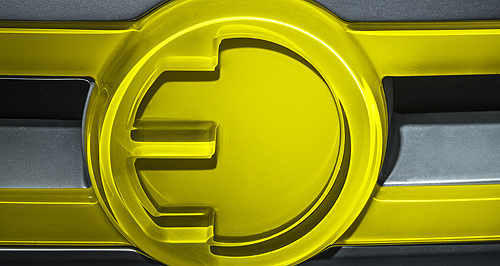Future models - Mini - EMini gives green light to EVElectric future opens up for Mini as BMW announces UK-made three-door EV26 Jul 2017 MINI has committed to an electric future, not only confirming the debut of a series-production all-electric version of its three-door hatchback core model in 2019 but announcing that more such electrified variants will follow. The new battery powered hatch will be built in Britain, at Mini’s Oxford factory, but employ a powertrain produced in Germany at the same e-mobility plants that turn out similar items for parent company BMW’s electrified vehicles, including the BMW i3. Mini has already launched a plug-in hybrid version of the Mini Countryman – the Cooper SE Countryman ALL4 – in the United Kingdom and Europe. BMW Group Australia is yet to commit to the PHEV Countryman or the newly announced electric three-door Mini, but product communications manager Adam Davis told GoAuto that both vehicles were “in the mix” for potential launch in this market, subject to business case scrutiny. Mini’s Australian management is expected to announce more on its plans for such vehicles at the Mini Countryman JCW launch next month. As GoAuto has reported, the PHEV Countryman has already received Australian Design Rule (ADR) homologation approval for the Australian market. Potentially, the company will introduce the PHEV Countryman as a test case while deciding whether to go all the way with the Mini EV. BMW Group Australia has been a staunch critic of Australian government inaction on environmentally friendly vehicles, pointing to assistance given to EVs in other countries. No technical or performance details for the new electric hatch were given in the overnight announcement from BMW’s Munich headquarters. Although the new vehicle will be Mini’s first series production EV, it is the not the first all-electric car from the British marque. In 2008, Mini rolled out 500 two-seat Mini E hatches on one-year leases in the United States as a toe-in-the-water exercise. That version had a 150kW/220Nm electric motor driving the front wheels, drawing power from a 35kWh lithium-ion battery – one of the first of its kind in the motor industry. Driving range was said to be more than 240km. These figures are similar to those of the current BMW i3 since its update in October 2016. BMW says lessons from the Mini E played a crucial role in the subsequent development of the BMW i3 and BMW i8. The company said it expects electrified vehicles to account for between 15 and 25 per cent of its of sales by 2025. “However, factors such as regulation, incentives and charging infrastructure will play a major role in determining the scale of electrification from market to market,” it said. “In order to react quickly and appropriately to customer demand, the BMW Group has developed a uniquely flexible system across its global production network. “In the future, the BMW Group production system will create structures that enable our production facilities to build models with a combustion engine, plug-in hybrid or fully electric drive train at the same time.” The next electrified vehicle from BMW will be the i8 Roadster in 2018, followed by an all-electric BMW X3 in 2020 and the BMW iNEXT in 2021.  Read more18th of July 2017  Oz case for plug-in hybrid Mini Countryman firmsMini scores federal approval to sell Countryman Cooper S E All4 plug-in hybrid in Oz24th of May 2017  Mini Countryman JCW sprints inHot Countryman is Mini’s priciest John Cooper Works variant10th of March 2017  Mini Aus delays Countryman PHEV confirmation callPetrol-electric Countryman faces tough questions from Mini AustraliaAll future models Alfa Romeo Alfa Romeo Abarth Abarth Audi Audi Aston Martin Aston Martin BMW BMW Bentley Bentley Chrysler Chrysler Chevrolet Chevrolet Dodge Dodge Citroen Citroen Ferrari Ferrari DS DS Ford Ford Fiat Fiat FPV FPV Foton Foton Haval Haval Great Wall Great Wall Honda Honda Holden Holden Hyundai Hyundai HSV HSV Isuzu Isuzu Infiniti Infiniti Jeep Jeep Jaguar Jaguar Lamborghini Lamborghini Kia Kia Lexus Lexus Land Rover Land Rover Mazda Mazda Maserati Maserati Mercedes-Benz Mercedes-Benz McLaren McLaren Mini Mini Nissan Nissan Mitsubishi Mitsubishi Peugeot Peugeot Opel Opel Proton Proton Porsche Porsche Renault Renault Ram Ram Saab Saab Rolls-Royce Rolls-Royce Smart Smart Skoda Skoda Subaru Subaru SsangYong SsangYong Tesla Tesla Suzuki Suzuki Toyota Toyota Volvo VolvoMotor industry news |
Click to shareMini modelsResearch Mini All future models Alfa Romeo Alfa Romeo Abarth Abarth Audi Audi Aston Martin Aston Martin BMW BMW Bentley Bentley Chrysler Chrysler Chevrolet Chevrolet Dodge Dodge Citroen Citroen Ferrari Ferrari DS DS Ford Ford Fiat Fiat FPV FPV Foton Foton Haval Haval Great Wall Great Wall Honda Honda Holden Holden Hyundai Hyundai HSV HSV Isuzu Isuzu Infiniti Infiniti Jeep Jeep Jaguar Jaguar Lamborghini Lamborghini Kia Kia Lexus Lexus Land Rover Land Rover Mazda Mazda Maserati Maserati Mercedes-Benz Mercedes-Benz McLaren McLaren Mini Mini Nissan Nissan Mitsubishi Mitsubishi Peugeot Peugeot Opel Opel Proton Proton Porsche Porsche Renault Renault Ram Ram Saab Saab Rolls-Royce Rolls-Royce Smart Smart Skoda Skoda Subaru Subaru SsangYong SsangYong Tesla Tesla Suzuki Suzuki Toyota Toyota Volvo VolvoMotor industry news |
















Facebook Twitter Instagram